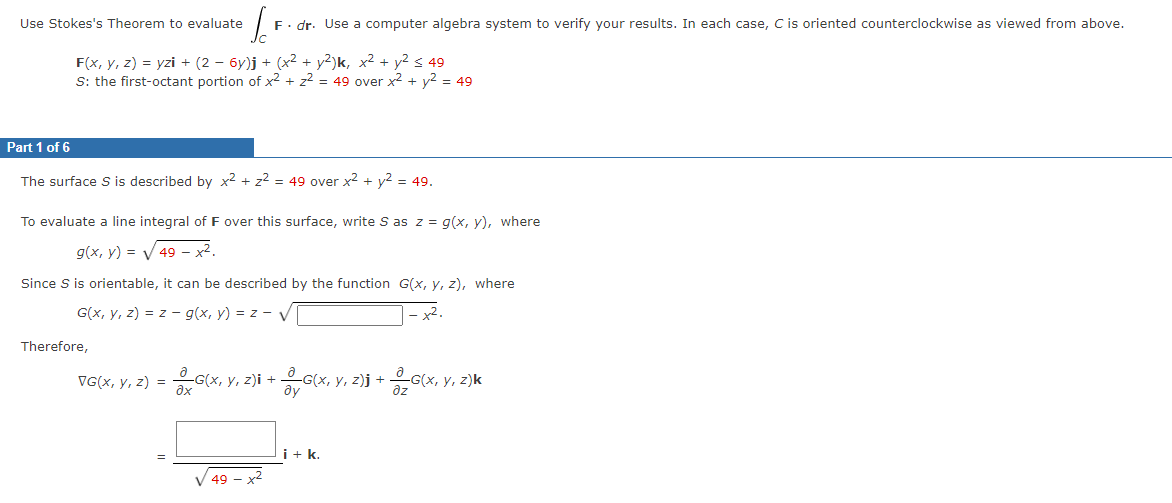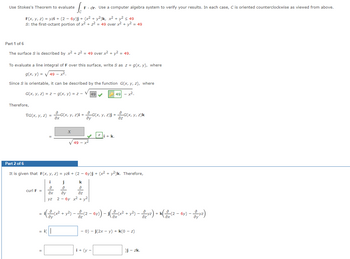Use Stokes's Theorem to evaluate F. dr. Use a computer algebra system to verify your results. In each case, C is oriented counterclockwise as viewed from above. F(x, y, z) = yzi + (2-6y)j + (x² + y²)k, x² + y² ≤ 49 S: the first-octant portion of x2 + z² = 49 over x² + y² = 49 art 1 of 6 The surface S is described by x² + z² = 49 over x² + y² = 49. To evaluate a line integral of F over this surface, write S as z = g(x, y), where g(x, y) = √√√49x². Since S is orientable, it can be described by the function G(x, y, z), where G(x, y, z) = z g(x, y) = z √ x². Therefore, VG(x, y, z)=G(x, y, z)i + · G(x, y, z)j +G(X, Y, y, z)k ду 49 x² i + k.
Use Stokes's Theorem to evaluate F. dr. Use a computer algebra system to verify your results. In each case, C is oriented counterclockwise as viewed from above. F(x, y, z) = yzi + (2-6y)j + (x² + y²)k, x² + y² ≤ 49 S: the first-octant portion of x2 + z² = 49 over x² + y² = 49 art 1 of 6 The surface S is described by x² + z² = 49 over x² + y² = 49. To evaluate a line integral of F over this surface, write S as z = g(x, y), where g(x, y) = √√√49x². Since S is orientable, it can be described by the function G(x, y, z), where G(x, y, z) = z g(x, y) = z √ x². Therefore, VG(x, y, z)=G(x, y, z)i + · G(x, y, z)j +G(X, Y, y, z)k ду 49 x² i + k.
Calculus: Early Transcendentals
8th Edition
ISBN:9781285741550
Author:James Stewart
Publisher:James Stewart
Chapter1: Functions And Models
Section: Chapter Questions
Problem 1RCC: (a) What is a function? What are its domain and range? (b) What is the graph of a function? (c) How...
Related questions
Question
15.8-9

Transcribed Image Text:Use Stokes's Theorem to evaluate
F(x, y, z) = yzi + (2 − 6y)j + (x² + y²)k, x² + y² ≤ 49
S: the first-octant portion of x² + z² = 49 over x² + y² = 49
Jo F. dr. Use a computer algebra system to verify your results. In each case, C is oriented counterclockwise as viewed from above.
Part 1 of 6
The surface S is described by x² + z² = 49 over x² + y² = 49.
To evaluate a line integral of F over this surface, write S as z = g(x, y), where
g(x, y) = √√49x².
Since S is orientable, it can be described by the function G(x, y, z), where
G(x, y, z) = z
g(x, y) = z v
Therefore,
VG(x, y, z) =
=
_G(x, y, z)i + _O_G(x, y, z)j + ₂G(x, y, z)k
ax
ay
√49 - x²
i + k.
Expert Solution
This question has been solved!
Explore an expertly crafted, step-by-step solution for a thorough understanding of key concepts.
This is a popular solution!
Trending now
This is a popular solution!
Step by step
Solved in 2 steps

Follow-up Questions
Read through expert solutions to related follow-up questions below.
Follow-up Question
15.8-9 please help solve remained of question

Transcribed Image Text:Use Stokes's Theorem to evaluate
F(x, y, z) = yzi + (2 − 6y)j + (x² + y²)k, x² + y² ≤ 49
S: the first-octant portion of x² + z² = 49 over x² + y² = 49
Part 1 of 6
The surface S is described by x² + z² = 49 over x² + y² = 49.
To evaluate a line integral of F over this surface, write S as z = g(x, y), where
g(x, y) = √√49x².
Since S is orientable, it can be described by the function G(x, y, z), where
G(x, y, z) = z
g(x, y) = z-V 49
Therefore,
VG(x, y, z) =
curl F =
ScF F. dr. Use a computer algebra system to verify your results. In each case, C is oriented counterclockwise as viewed from above.
=
ə
X
= i(||
G(x, y, z)i +G(x, y, z)j + G(x, y, z)k
дz
?х
Part 2 of 6
It is given that F(x, y, z) = yzi + (2 − 6y)j + (x² + y²)k. Therefore,
i
j
k
ə
Ə
əx ду
əz
yz 2-6y x² + y²
49
49 -².
X + k.
−(x² + y²) - 0₂ (2 − 6y)) - ³(2x (x² + y²) − 0₂y²) + k( 0 (2 − 6y) - 8yz)
y²)
əy
дz
i + (y-
- 0) - j(2x - y) + k(0 - z)
)j - zk.
Solution
Recommended textbooks for you

Calculus: Early Transcendentals
Calculus
ISBN:
9781285741550
Author:
James Stewart
Publisher:
Cengage Learning

Thomas' Calculus (14th Edition)
Calculus
ISBN:
9780134438986
Author:
Joel R. Hass, Christopher E. Heil, Maurice D. Weir
Publisher:
PEARSON

Calculus: Early Transcendentals (3rd Edition)
Calculus
ISBN:
9780134763644
Author:
William L. Briggs, Lyle Cochran, Bernard Gillett, Eric Schulz
Publisher:
PEARSON

Calculus: Early Transcendentals
Calculus
ISBN:
9781285741550
Author:
James Stewart
Publisher:
Cengage Learning

Thomas' Calculus (14th Edition)
Calculus
ISBN:
9780134438986
Author:
Joel R. Hass, Christopher E. Heil, Maurice D. Weir
Publisher:
PEARSON

Calculus: Early Transcendentals (3rd Edition)
Calculus
ISBN:
9780134763644
Author:
William L. Briggs, Lyle Cochran, Bernard Gillett, Eric Schulz
Publisher:
PEARSON

Calculus: Early Transcendentals
Calculus
ISBN:
9781319050740
Author:
Jon Rogawski, Colin Adams, Robert Franzosa
Publisher:
W. H. Freeman


Calculus: Early Transcendental Functions
Calculus
ISBN:
9781337552516
Author:
Ron Larson, Bruce H. Edwards
Publisher:
Cengage Learning